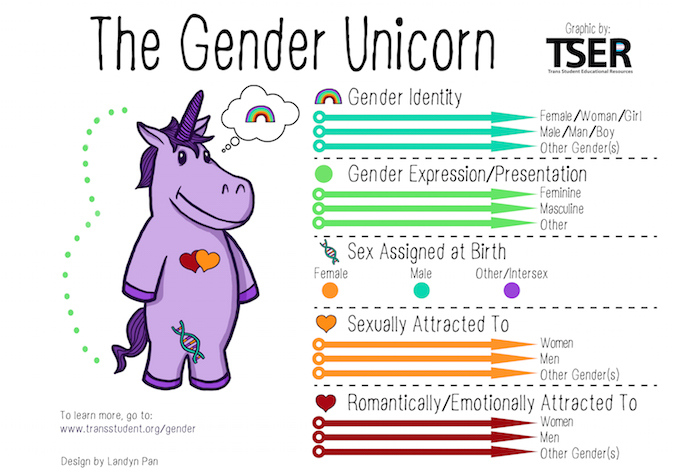Before We Begin. . .
We're providing what we believe to be the most up to date and accurate terminology, but
the language used by the LGBTQ+ community is constantly changing and evolving.
Everyone has the right to differences of opinion about what terms to use,
what's okay to say, and what certainly is not.
However, we think that this is a good beginning for someone trying to learn this terminology.
Please note that no one should ever apply a label to someone without their consent.
And remember that this terminology may not be a perfect fit for everyone, nor should it be expected to!
This is a visual guide to help in the understanding of the distinctions between gender,
sex, orientation, and gender expression.
Introducing: The Gender Unicorn

We'd like to introduce our Unicorn friend from Trans Student Educational Resources! They're here to explain how Gender identity, Sex Assigned at Birth, Gender Expression, and Sexual and Romantic Attraction are independent parts of our identities that sometimes do and sometimes don't interact with each other.
Gender Identity
One's innate sense of which gender(s) they are within themselves. Gender identity refers to how we think about ourselves, which is why the gender unicorn's identity is in part of their brain! Most often, a person is Cisgender when they identify as the gender they were assigned at birth. A Transgender, or Trans person is most often someone who identifies differently from the gender they were assigned at birth.
Sex Assigned at Birth
We're born, and then often with haste, are categorized as male or female sexed. This of course, leads to everyone we know attributing a gender to us, which can pose significant difficulty, oppression, and sometimes danger for trans people. It turns out that sex is a lot more complicated than we might think. At least one in one thousand people born are intersex in some way, meaning that their chromosomes, hormones, or bodily characteristics aren't exactly identical to what medical professionals would assign as male or female sexed. Intersex people identify as cis, trans, or however else they please. Another hurdle with the category of "sex" is how people think about their bodies. Despite cultural beliefs, it isn't necessary to categorize features of the body as particularly male, female, or other. Ideas about the connection between gender and sex are a societal phenomenon. Who said that ____ part of the body had to be just for one group of people?
Orientation
Our romantic and sexual orientations affect our hearts and minds- and sometimes other parts! These two types of attraction are independent of each other, but sometimes work together. For example, someone might feel romantically attracted to others but have limited to no sexual attraction for them (asexuality). Or, a person could experience romantic or sexual attraction for some people but not all in the same exact way!
Expression
How one presents their gender, through clothes, make up, hair cuts, socialization, body movement, and more. It is possible to have a gender expression consistent with a gender that doesn't reflect their gender identity. This could be for reasons of preference, or sometimes safety. A trans person might not feel comfortable presenting a certain way in some locations. Another example of how gender expression can be different from one's identity are drag performers, who may be cross dressing, or presenting as a different gender than how they identify. Very often, people express their gender in a way that corresponds to their gender identity. For example, a masculine identified person might choose to wear clothes that they feel express their masculinity.
